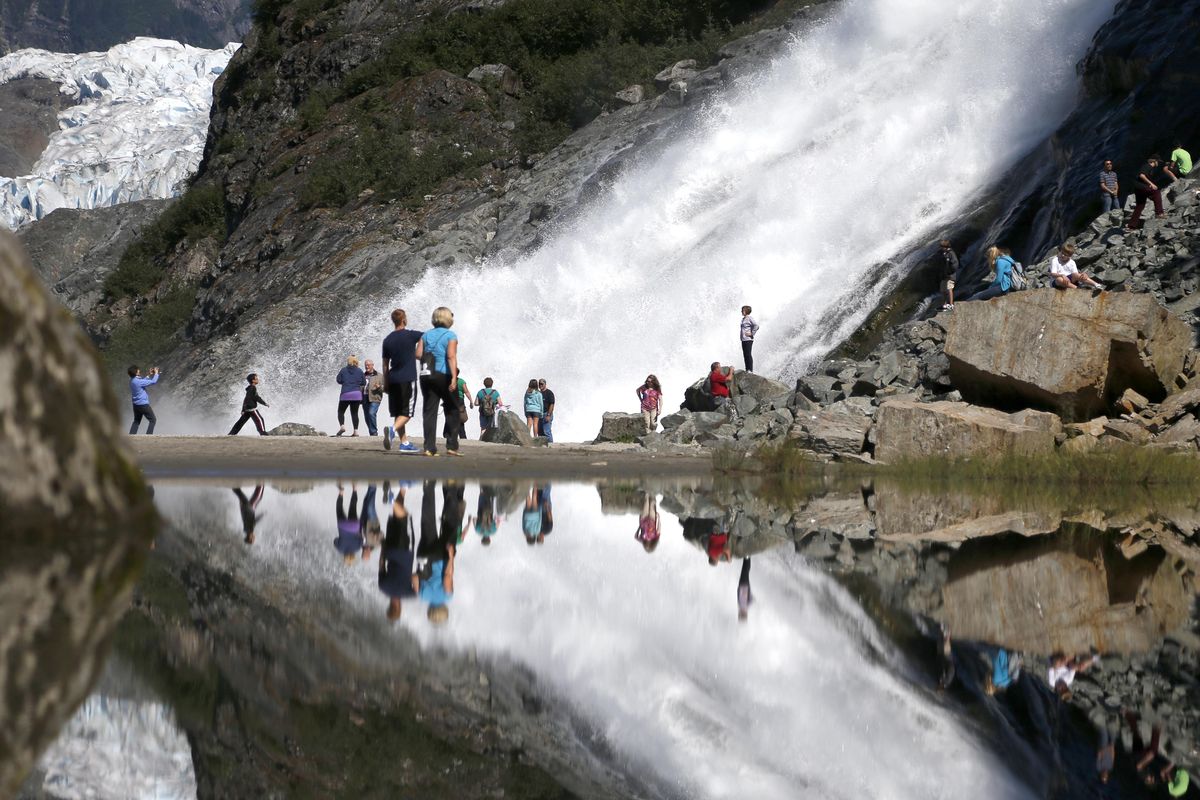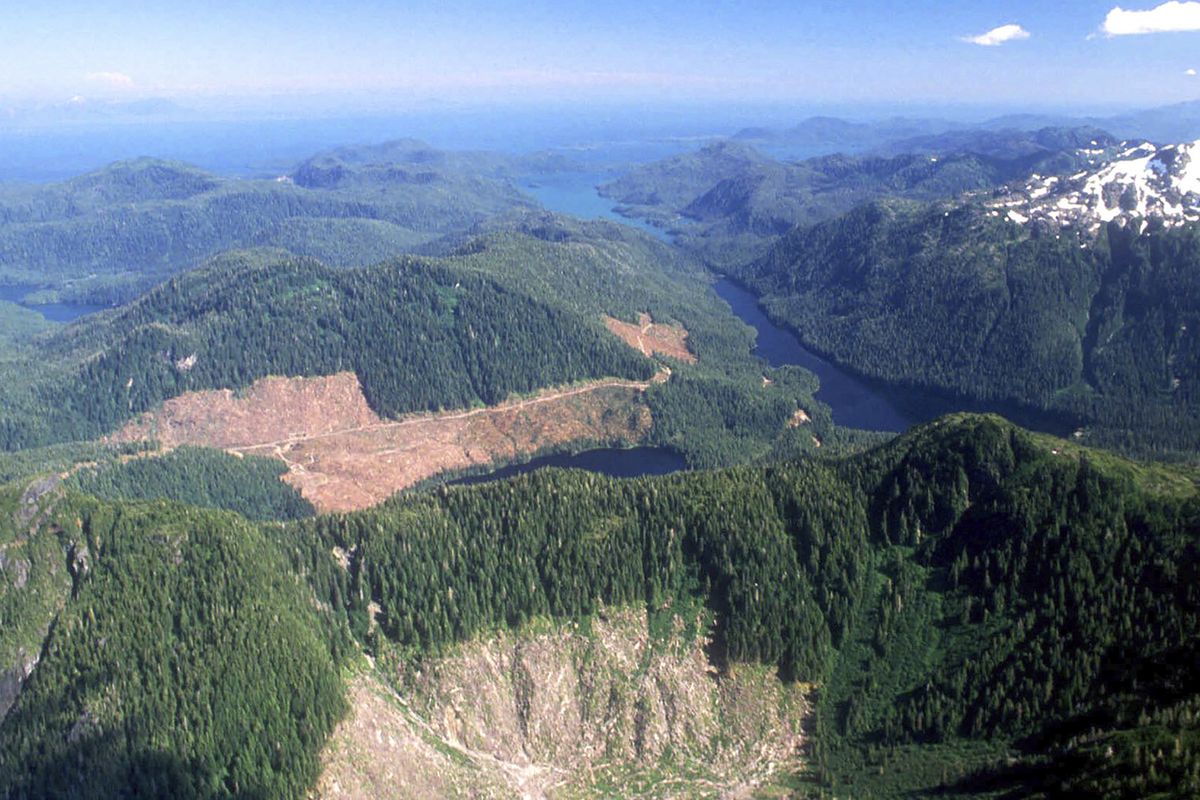Road, logging restrictions to end in largest national forest
Tourists visiting the Mendenhall Glacier in the Tongass National Forest are reflected in a pool of water July 31, 2013, as they make their way to Nugget Falls in Juneau, Alaska. (Associated Press)
WASHINGTON – The Trump administration lifted logging protections on the majority of the nearly 17-million-acre Tongass National Forest in Alaska, the latest in a series of steps in the final weeks of the president’s first term to give industry access to the state’s rugged and fragile wilderness.
In a notice posted Wednesday, the Forest Service rolled back logging restrictions on more than 9.3 million acres of the Tongass – one of the world’s few remaining old-growth temperate rainforests – that have guarded the ecosystem since 2001.
And in August, the Interior Department released a separate plan to drill in the 19-million-acre refuge on a coastal stretch of the region known as the 1002 Area. That coastal plan area is separate from the area in which the Willow project could come online.
It will be legal Thursday for logging companies to erect roads and cut down trees. The restrictions that had been in place, called the “roadless rule,” have protected about 60 million acres of federal forests in 39 states since it was finalized by the Clinton administration. As the name suggests, the rule prevents road construction and, in turn, logging.
Alaska Gov. Mike Dunleavy, a Republican, and its congressional delegation lobbied the administration to eliminate the roadless rule’s application in the state.
As the Trump administration approaches Election Day, federal agencies have taken a flurry of steps in the last week to weaken environmental protections in Alaska, and their steps could have an impact in a matter of days or weeks.
The Bureau of Land Management approved plans Tuesday for oil-and-gas giant ConocoPhillips to build three drill sites, gravel roads and pipelines, as well as airstrips, for the company’s Willow project, located along the Arctic Ocean in the state’s northwest. BLM said that the project “could produce” as much as 160,000 barrels of oil daily for 30 years.
That decision followed an announcement Friday, also from BLM, to permit seismic tests in the ecologically sensitive Arctic National Wildlife Refuge. Seismic testing, which requires loud blasting in the search for petroleum deposits, could start as soon as December.
The Alaska congressional delegation cheered the approval for the construction of the Willow project.
The administration made its moves under a newly tweaked version of the National Environmental Policy Act, or NEPA, a long-standing law that requires federal agencies to scrutinize the ecological costs of major projects such as oil drilling. The outcome could be truck traffic and construction before the year ends.
Over the summer the White House overhauled NEPA, which has been on the books since the 1970s, to reduce the time in which environmental impact statements and assessments must be completed, limit the length of those documents and modify how climate change should be considered under the statute.
“I’ve been wanting to do this since day one,” President Donald Trump told an audience in July at a UPS warehouse in Atlanta. Under the new version of NEPA, it will be easier to approve infrastructure projects like highways, Trump said.
Drilling in ANWR has long been a Republican goal, but GOP lawmakers have been thwarted for decades from tapping into the region, which is thought to possess beneath its crust billions of barrels of oil.
At the urging of Sen. Lisa Murkowski, R-Alaska, a provision to allow drilling in ANWR made its way into the 2017 tax legislation that became law.
“The Willow project alone will be massive and bring to our state hundreds of good-paying jobs for hard-working Alaskans,” Sen. Dan Sullivan, R-Alaska, said, adding that the National Strategic Petroleum Reserve-Alaska, the federal area in question, is “slated to be among the hottest energy prospects in the world.”
The BLM manages the NPR-A, which spans more than 23 million acres on Alaska’s North Slope.
A U.S. Geological Survey study released this month found oil and gas drilling could harm 34% of maternal polar bear dens in the Alaskan Arctic.
“The attacks on the Arctic just continue to escalate,” Nicole Whittington-Evans, Alaska program director for Defenders of Wildlife, said in a statement. “The finalization of oil and gas plans for the Willow project and the Arctic National Wildlife Refuge are a one-two punch to wildlife including imperiled Southern Beaufort Sea polar bears and their critical habitat,” Whittington-Evans said. “Despite the urgent need to ramp down our carbon emissions, as the Arctic continues to melt, the Bureau of Land Management just continues its drumbeat to drill for fossil fuels.”
One resource-extraction project supported by the administration but opposed by Murkowski and Sullivan is the so-called Pebble Mine, a gold, copper and molybdenum site near Bristol Bay, which has divided the state politically and is near the world’s biggest salmon run. Murkowski said this month she would use the appropriations process to block approval of the project.
Sullivan, who is running for reelection against Al Gross, an independent, came out against the mine Aug. 24 following the Army Corps of Engineers’ decision that the project did not meet federal water permitting guidelines. Inside Elections with Nathan L. Gonzales rates the election “likely Republican,” though the race has proven tighter than expected.
After spending billions of dollars, Royal Dutch Shell in 2015 abandoned its efforts to drill for oil in the Arctic Ocean off the Alaskan coast, a high-profile exit that sent shock waves through the industry.
Drilling in frigid waters is notoriously difficult. It is more expensive than drilling in other climates, requires different technical training, has a shorter season and requires higher oil prices to financially justify.

